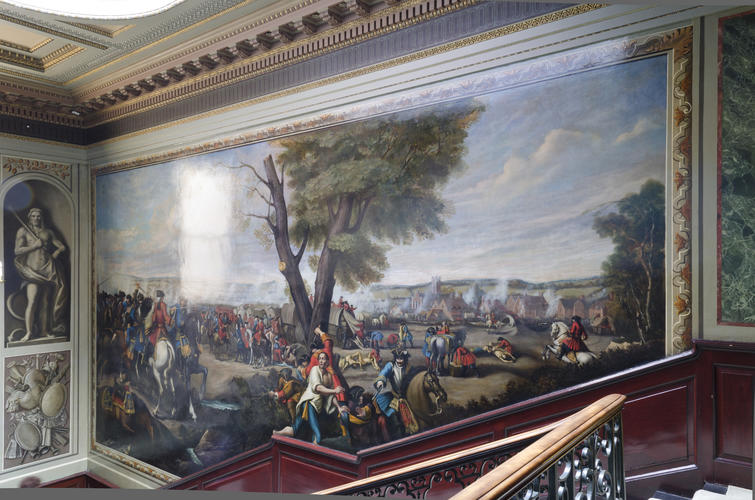-
1 of 253523 objects
The Battle of Ramilles, 23 May 1706: The Rout of the French from the Village of Ramillies at the Close of the Battle (1713-14
Oil on plaster | 437 x 849 cm (image) | RCIN 408434

Louis Laguerre (1663-1721) and assistants
The Battle of Ramilles, 23 May 1706: The Rout of the French from the Village of Ramillies at the Close of the Battle (1713-14


-
In 1713 Louis Laguerre was commissioned to decorate the walls of the main hall and the two flanking staircases of Marlborough House, the London residence of the Duke and Duchess of Marlborough. The subject was to be the significant battles of the Spanish Wars of Succession (1701-14); led by the Duke of Marlborough, Britain and the Allies saw victories at Blenheim (1704), Ramillies (1706), Oudenard (1708) and, less decisively, Malplaquet (1709). The murals were to be 'the only signs of bravura or ornamentation in a house that was otherwise very plain and simple' (John Charlton, Marlborough House, 1978). Laguerre was paid £500 for them. The murals have had a chequered conservation history and parts have been almost entirely repainted.
Here, the French run, in confusion, around the village of Ramillies: a group of corpses in the middle of the composition are being stripped. By the end of the day, the French had been weakened and were closing up; a decisive charge was led by the Duke of Wurttemburg and the Danish horse, later joined by Marlborough and Overkirk. The French were unable to bring their full force against this, since the baggage carts and tents they had left out that morning restricted their room for manoeuvre. Captain Peter Drake, an Irish soldier then fighting on the French side (though formerly a pikeman in Marlborough's regiment), described the scene as the French fled: 'They indeed acquitted themselves shamefully and fled, with great Precipitation, like frighted Sheep; insomuch, that I saw one of their best (called the King's) Regiment, composed of four Battallions, lay down their Arms like Paltroons, and surrender themselves Prisoners of War. In short, they all left the Field with infinite Disgrace.' As many as 18,000 of Marshall Villeroi’s men were killed or captured at the battle.
Laguerre's composition gives a sense of the confusion of the scene, with the central figure in blue running across the village in terror. However, much of the paint handling is uncharacteristic of the eighteenth century, with a crudeness and thickness that suggests it may be overpainting from a campaign of restoration in the 1960s.
A small oil copy, 30 x 54 inches, at Plas Newydd, and one, 29 x 57 inches, (inscribed Tanniers) at Adare Manor; a large copper plate engraving by Du Bosc and Du Guernier in the National Army Museum.
Provenance
Commissioned by the 1st Duke and Duchess of Marlborough
-
Creator(s)
-
Medium and techniques
Oil on plaster
Measurements
437 x 849 cm (image)
67.5 x 90 cm (image)
Category
Object type(s)